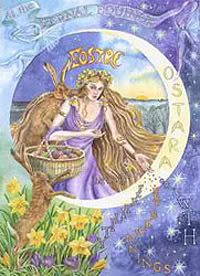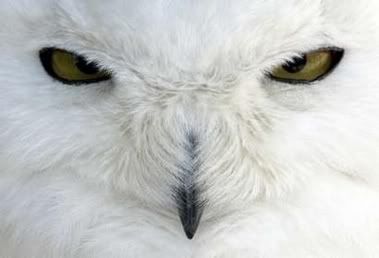Post by ivymoon on Mar 5, 2009 12:25:35 GMT -5
Celebrated on the Spring Equinox, around March 21 each year.
Ostara is also known as the Spring Equinox, the Vernal Equinox, Lady Day, Eostara, Easter, Alban Eiber, and Bacchanalia.
Ostara is a festival of fertility and growth. Ostara occurs on the Spring Equinox, the first day of Spring. On this day, darkness and light are in balance. From this day onward, day will dominate the night and the Earth will explode with life. Ostara is a celebration of this renewal and rebirth of nature and warming of the Earth. As mirrors of the world around us, this is an ideal time to put plans into action for growth in our own lives, to actively encourage change.
The name for this Sabbat is derived from the Teutonic lunar Goddess Eostre. Her chief symbols were the rabbit (for fertility, and her worshippers often saw the image of a rabbit in the full moon), and the egg (representing the cosmic egg of creation). This is where the customs of "Easter Eggs" and the "Easter Bunny" originated.
A tradition that did not exactly move over into the popular celebration of Easter was having sex in freshly plowed fields. This tradition came from the pagan farmers who would finish plowing and planting their fields. Once the crops were all planted, the farmer and his wife would make love in the field, the idea being that the fertility of their sexual act would help the plants grow into a bountiful crop. Another variant of this is leaping in the fields. Instead of having sex in the freshly plowed fields, the farmer and his family would go out into the field and leap as high as they could into the air, with the idea that the crops would grow as high as their leaps into the air. This is an example of sympathetic magick, where the crops are supposed to imitate the actions of the farmer's family.
Correspondences
Symbolism: The beginning of spring, new life and rebirth, the God and Goddess in Their youth, balance
Symbols: Eggs, rabbits
Foods: Hard-boiled eggs, honey cakes, fresh fruits, milk punch, leafy green vegetables, dairy foods, apples
Plants & herbs: Acorn, celandine, cinquefoil, croqus, daffodil, dogwood, easter lily, honeysuckle, iris, jasmine, rose, tansy, violets
Incense and oils: African violet, jasmine, rose, strawberry, lotus, magnolia, ginger
Colors: Light green, lemon yellow, and pale pink
Stones: Amethyst, aquamarine, bloodstone, red jasper
Animals and mythical beasts: Rabbits, snakes, unicorns
Some appropriate Goddesses: all love, virgin, and fertility Goddesses; Anna Perenna (Roman), Aphrodite (Greek), Astarte (Canaanite), Athena (Greek), Cybele (Greco-Roman), Eostre (Teutonic), Flidais (Irish), Gaia (Greek), Ishtar (Assyro-Babylonian), Isis (Egyptian), Libera (Roman), Minerva (Roman), The Muses (Greek), Persephone (Greek), Renpet (Egyptian), Venus (Roman)
Some appropriate Gods: all love, song & dance, and fertility Gods; Adonis (Greek), Attis (Greco-Roman), Cernunnos (Celtic), The Great Horned God (European), Liber (Roman), Mars (Roman), Mithras (Persian), Odin (Norse), Osiris (Egyptian), Pan (Greek)
Decorations: Daffodils, tulips, violet, iris, narcissus, any spring flowers, eggs, butterflies, cocoons
Activities: Dying eggs, planting seeds (for plants and plans), lighting fires, ringing bells, looking for spring growth, buying a new besom or staff, spring cleaning
Spell/ritual work: Garden/plant blessings, balance, growth, communication

Ostara is also known as the Spring Equinox, the Vernal Equinox, Lady Day, Eostara, Easter, Alban Eiber, and Bacchanalia.
Ostara is a festival of fertility and growth. Ostara occurs on the Spring Equinox, the first day of Spring. On this day, darkness and light are in balance. From this day onward, day will dominate the night and the Earth will explode with life. Ostara is a celebration of this renewal and rebirth of nature and warming of the Earth. As mirrors of the world around us, this is an ideal time to put plans into action for growth in our own lives, to actively encourage change.
The name for this Sabbat is derived from the Teutonic lunar Goddess Eostre. Her chief symbols were the rabbit (for fertility, and her worshippers often saw the image of a rabbit in the full moon), and the egg (representing the cosmic egg of creation). This is where the customs of "Easter Eggs" and the "Easter Bunny" originated.
A tradition that did not exactly move over into the popular celebration of Easter was having sex in freshly plowed fields. This tradition came from the pagan farmers who would finish plowing and planting their fields. Once the crops were all planted, the farmer and his wife would make love in the field, the idea being that the fertility of their sexual act would help the plants grow into a bountiful crop. Another variant of this is leaping in the fields. Instead of having sex in the freshly plowed fields, the farmer and his family would go out into the field and leap as high as they could into the air, with the idea that the crops would grow as high as their leaps into the air. This is an example of sympathetic magick, where the crops are supposed to imitate the actions of the farmer's family.
Correspondences
Symbolism: The beginning of spring, new life and rebirth, the God and Goddess in Their youth, balance
Symbols: Eggs, rabbits
Foods: Hard-boiled eggs, honey cakes, fresh fruits, milk punch, leafy green vegetables, dairy foods, apples
Plants & herbs: Acorn, celandine, cinquefoil, croqus, daffodil, dogwood, easter lily, honeysuckle, iris, jasmine, rose, tansy, violets
Incense and oils: African violet, jasmine, rose, strawberry, lotus, magnolia, ginger
Colors: Light green, lemon yellow, and pale pink
Stones: Amethyst, aquamarine, bloodstone, red jasper
Animals and mythical beasts: Rabbits, snakes, unicorns
Some appropriate Goddesses: all love, virgin, and fertility Goddesses; Anna Perenna (Roman), Aphrodite (Greek), Astarte (Canaanite), Athena (Greek), Cybele (Greco-Roman), Eostre (Teutonic), Flidais (Irish), Gaia (Greek), Ishtar (Assyro-Babylonian), Isis (Egyptian), Libera (Roman), Minerva (Roman), The Muses (Greek), Persephone (Greek), Renpet (Egyptian), Venus (Roman)
Some appropriate Gods: all love, song & dance, and fertility Gods; Adonis (Greek), Attis (Greco-Roman), Cernunnos (Celtic), The Great Horned God (European), Liber (Roman), Mars (Roman), Mithras (Persian), Odin (Norse), Osiris (Egyptian), Pan (Greek)
Decorations: Daffodils, tulips, violet, iris, narcissus, any spring flowers, eggs, butterflies, cocoons
Activities: Dying eggs, planting seeds (for plants and plans), lighting fires, ringing bells, looking for spring growth, buying a new besom or staff, spring cleaning
Spell/ritual work: Garden/plant blessings, balance, growth, communication


